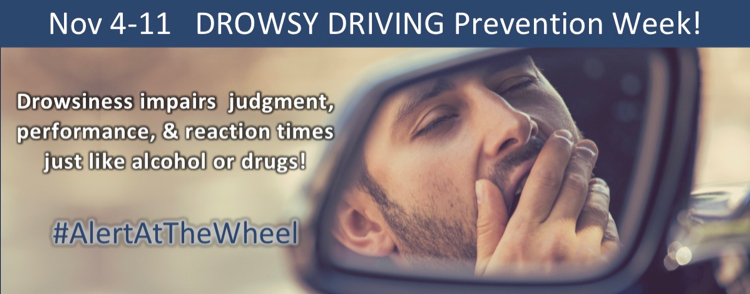 The National Sleep Foundation (NSF) has designated the first full week in November (this year Nov 4-11 2018) as National Drowsy Driving Prevention Week. Most people are aware of the dangers of drunk driving and distracted driving. The dangers of drowsy driving are not as well known but are just as real. In fact, sleep-deprived drivers cause more than 6,400 deaths and 50,000 debilitating injuries on American roadways each year. 1
The National Sleep Foundation (NSF) has designated the first full week in November (this year Nov 4-11 2018) as National Drowsy Driving Prevention Week. Most people are aware of the dangers of drunk driving and distracted driving. The dangers of drowsy driving are not as well known but are just as real. In fact, sleep-deprived drivers cause more than 6,400 deaths and 50,000 debilitating injuries on American roadways each year. 1
Drowsy driving is when a driver is fatigued due to lack of sleep. Drowsy drivers have diminished awareness, delayed braking and can even fall asleep at the wheel. Studies show that being awake for more than 20 hours results in an impairment equal to a blood alcohol concentration of 0.08, the legal limit in all states. 2
Drowsy drivers often recognize the signs of their fatigue but have a difficult time or underestimate how soon they will fall asleep. The most common symptoms of drowsy driving are consistent yawning, wondering thoughts, drifting into other lanes, missing exits, irritability and feeling the need to turn up the radio or roll down the windows.
Who is at risk of drowsy driving? Sadly, it is more common than you’d think. According to National Sleep Foundation surveys, half of Americans report they have driven while drowsy and as many as 20% report they have even fallen asleep at the wheel. 2 Anyone behind the wheel is at risk of drowsy driving. There are some groups however who are at greater risk. These include:
- Young, inexperienced drivers who often drive late at night.
- Men are twice as likely to drive drowsy as women. Especially men aged 16-25.
- People who work nights and rotating shifts.
- Commercial drivers who drive a high number of miles and drive at night. These same drivers are also at high risk of sleep disorders.
- People with untreated sleep disorders such as obstructive sleep apnea (OSA) –
The good news is that drowsy driving can be prevented. Drivers who consistently get at least 8 hours of sleep each night are at much lower risk of drowsy driving. This is attainable for most drivers through lifestyle adjustments and planning. It is more difficult however, for those who suffer from a sleep disorder.
People with sleeping disorders are at a greater continued risk of drowsy driving. For instance, people with untreated OSA are up to seven times more likely to have a drowsy driving crash.
For more information on how we may be able to help with treatment, see Patient Info
1 National Sleep Foundation Expert Consensus Panel Concludes that Missing a Night of Sleep Renders Driver Unfit to Operate a Motor Vehicle. May 2016.
2 National Sleep Foundation. Facts About Drowsy Driving. Sept 2016. Drowsydriving.org
